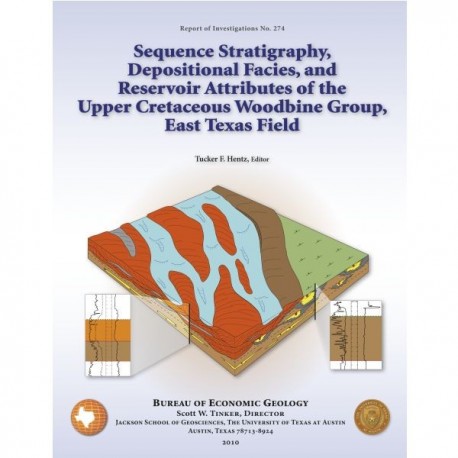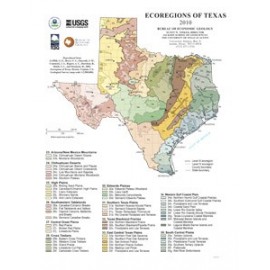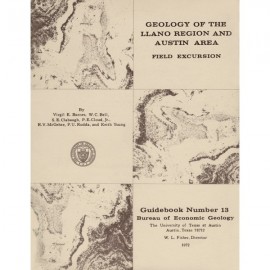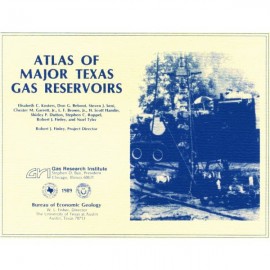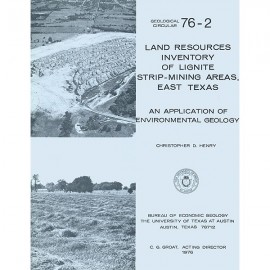Reports of Investigations
-
Books & Reports
- Reports of Investigations
- Guidebooks
- Udden Series
- Geological Circulars
- Down To Earth
- Atlases of Major Oil and Gas Reservoirs
- Texas Memorial Museum Publications
- Environmental Geologic Atlas of the Texas Coastal Zone
- Mineral Resource Circulars
- Other Reports
- Seminars and Workshops
- Handbooks
- Submerged Lands of Texas
- Symposia
- Annual Reports
- Open File Reports
-
Maps & Cross Sections
- Thematic Maps
- Miscellaneous Maps, Charts & Sections
- Geologic Atlas of Texas
- STATEMAP Project Maps
- Geologic Quadrangle Maps
- Cross Sections
- Highway Geology Map
- Energy and Mineral Resource Maps
- Shoreline Change and Other Posters
- Wilcox Group, East Texas, Geological / Hydrological Folios
- Bouguer Gravity Atlas of Texas
- River Basin Regional Studies
- Featured Maps
- Posters
- Teachers & the Public
-
Geological Society Publications
- Gulf Coast Association of Geological Societies
- Alabama Geological Society
- Austin Geological Society
- Corpus Christi Geological Society
- Houston Geological Society
- Lafayette Geological Society
- Mississippi Geological Society
- New Orleans Geological Society
- South Texas Geological Society
- GCS SEPM Publications
- Historic BEG & UT Series
Sequence Stratigraphy, Depositional Facies, and Reservoir Attributes of the Upper Cretaceous Woodbine Group, East Texas
RI0274
For a downloadable, digital version: RI0274D.
RI0274. Sequence Stratigraphy, Depositional Facies, and Reservoir Attributes of the Upper Cretaceous Woodbine Group, East Texas Field. T. F. Hentz, editor. 4 chapters, 114 p., 2010. Print.
To purchase this publication on CD-ROM, please order RI0274CD.
To purchase this publication as a downloadable PDF, please order RI0274D.
From the PREFACE
Although the mature, supergiant East Texas field on the west flank of the Sabine Uplift has been producing from the Upper Cretaceous (Cenomanian) siliciclastic Woodbine Group for more than 75 years, no modern comprehensive geologic study of it has been completed. This report presents results of an integrated geologic and reservoir-engineering analysis of the Woodbine interval in the field and adjacent East Texas Basin. The collective objective of the four papers that compose the report is to detail the primary attributes and controls on the field’s reservoir framework—chronostratigraphy, depositional facies, and character and quality of Woodbine reservoir sandstones—and their influence on fluid flow, incompletely swept reservoir zones, potential bypassed pay, and deeper pay zones.
This study represents a marked departure from previous geologic characterizations of the field and the Woodbine Group in the East Texas Basin by (1) integrating sequence-stratigraphic analysis of the Woodbine interval in the basin with that in the adjacent field and (2) detailing reservoir scale Woodbine depositional facies in the field using abundant well logs mostly unavailable to the public and analyzing previously undescribed conventional cores. Historic engineering data, largely unpublished and provided by the East Texas Engineering Association and other sources, have also been synthesized to help explain the production evolution of this historic Texas oil field.
Discovered in 1930, East Texas field has been the most productive oil field in the U.S. lower 48 states and the second largest in the country behind Prudhoe Bay field, Alaska. Primary hydrocarbon accumulation in the field is in west-dipping Woodbine strata that are truncated on the west flank of the Sabine Uplift by a subregional angular unconformity below impermeable calcareous siltstones of the Austin Chalk, which forms the top seal throughout the field. Reservoirs are associated with a strong water drive, resulting from a combination of regionally tilted Woodbine strata, inferred excellent sandstone-body continuity, and high porosity (averaging 20.9 percent) and permeability values (averaging 1.4 D). Excellent vertical and horizontal sweep efficiency contributes to an overall high-recovery factor of approximately 77 percent.
More than 31,200 wells have been drilled in the field, which encompasses approximately 134,000 acres (~210 mi2 [~544 km2]) in parts of Gregg, Rusk, Smith, and Upshur Counties of northeast Texas. The field had produced 5.42 billion stock-tank barrels of oil from Woodbine sandstones through mid-2007, although the advanced degree of water encroachment indicates that it is in the waning stages of production. Recent evaluation of the amount of bypassed pay, deeper Woodbine pay, and poorly swept oil, however, reveals that the field has remaining reserves of as much as 410 million stock-tank barrels of oil. Producers are now aggressively pursuing these reserves by targeting recompletions and especially deeper pay zones in the Woodbine section. It is the authors’ intent to provide a coherent model of the field’s reservoir system to enable more effective exploitation of its remaining oil.
Keywords: Cenomanian, depositional model, development strategies, East Texas Basin, East Texas field, enhanced oil recovery, field development, fluvial-dominated deltas, incised-valley systems, quartz overgrowths, reservoir engineering, recompletions, reservoir properties, sandstone petrography, sequence stratigraphy, systems tracts, Upper Cretaceous, waterfloods, well deepening, Woodbine Group
CONTENTS
Preface
Sequence Stratigraphy of the Upper Cretaceous (Cenomanian) Woodbine Group: Chronostratigraphic Integration of the East Texas Basin and East Texas Field, by Tucker F. Hentz and Florence Bonnaffé
Depositional Systems and Facies Variability in Highstand Fluvial- Dominated Deltaic and Lowstand Valley-Fill Systems in the Lower Cretaceous (Cenomanian) Woodbine Group, East Texas Field, by William A. Ambrose and Tucker F. Hentz
Petrographic Controls on Reservoir Quality of the Upper Cretaceous Woodbine Group, East Texas Field, by Robert G. Loucks
Engineering Characterization of East Texas Oil Field: North and South Pilot Studies, by Fred P. Wang
Citation
Hentz, T. F., editor, 2010, Sequence Stratigraphy, Depositional Facies, and Reservoir Attributes of the Upper Cretaceous Woodbine Group, East Texas Field: The University of Texas at Austin, Bureau of Economic Geology, Report of Investigations No. 274, 114 p.
